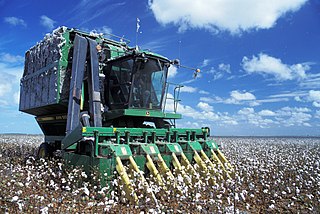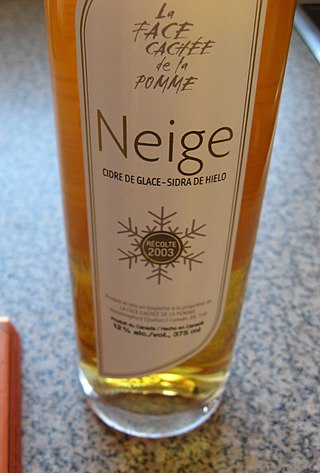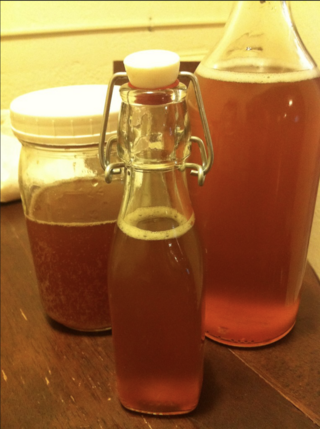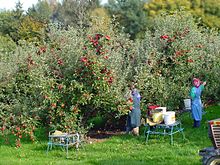
A fruit press is a device used to separate fruit solids—stems, skins, seeds, pulp, leaves, and detritus—from fruit juice.
Perry or pear cider is an alcoholic beverage made from fermented pears, traditionally in England, particularly Gloucestershire, Herefordshire, and Worcestershire, parts of South Wales and France, especially Normandy and Anjou, Canada, Australia and New Zealand.

An orchard is an intentional plantation of trees or shrubs that is maintained for food production. Orchards comprise fruit- or nut-producing trees that are generally grown for commercial production. Orchards are also sometimes a feature of large gardens, where they serve an aesthetic as well as a productive purpose. A fruit garden is generally synonymous with an orchard, although it is set on a smaller, non-commercial scale and may emphasize berry shrubs in preference to fruit trees. Most temperate-zone orchards are laid out in a regular grid, with a grazed or mown grass or bare soil base that makes maintenance and fruit gathering easy.

Winemaking or vinification is the production of wine, starting with the selection of the fruit, its fermentation into alcohol, and the bottling of the finished liquid. The history of wine-making stretches over millennia. There is evidence that suggests that the earliest wine production took place in Georgia and Iran around 6000 to 5000 B.C. The science of wine and winemaking is known as oenology. A winemaker may also be called a vintner. The growing of grapes is viticulture and there are many varieties of grapes.

Apple juice is a fruit juice made by the maceration and pressing of an apple. The resulting expelled juice may be further treated by enzymatic and centrifugal clarification to remove the starch and pectin, which holds fine particulate in suspension, and then pasteurized for packaging in glass, metal, or aseptic processing system containers, or further treated by dehydration processes to a concentrate.
Bulmers cider is one of a number of brands owned by British cider maker H. P. Bulmer of Hereford, an Heineken subsidiary, It is one of the biggest selling British bottled cider brands in the UK because it has the highest concentration of apples, with a number of variants including Bulmers Original & Pear. It should not be confused with Bulmers Irish Cider, sold outside the Republic of Ireland as Magners.

Cider apples are a group of apple cultivars grown for their use in the production of cider. Cider apples are distinguished from "cookers" and "eaters", or dessert apples, by their bitterness or dryness of flavour, qualities which make the fruit unpalatable but can be useful in cidermaking. Some apples are considered to occupy more than one category.

Seasonal human migration is the movement of people from one place or another on a seasonal basis. It occurs most commonly due to seasonal shifts in demand for labor. It includes migrations such as moving sheep or cattle to higher elevations during summer to escape the heat and find more forage. Human labor often moves with fruit harvest or to other crops that require manual picking.

Malus domestica is an English cultivar of apple that is usually eaten cooked due to its sourness. The variety comes from a pip planted by Mary Ann Brailsford. The Concise Household Encyclopedia states, "Some people eat this apple raw in order to cleanse the palate, but Bramley's seedling is essentially the fruit for tart, pie, or dumpling." Once cooked, however, it has a lighter flavour. A peculiarity of the variety is that when cooked it becomes golden and fluffy.

Mechanised agriculture or agricultural mechanization is the use of machinery and equipment, ranging from simple and basic hand tools to more sophisticated, motorized equipment and machinery, to perform agricultural operations. In modern times, powered machinery has replaced many farm task formerly carried out by manual labour or by working animals such as oxen, horses and mules.

An agricultural robot is a robot deployed for agricultural purposes. The main area of application of robots in agriculture today is at the harvesting stage. Emerging applications of robots or drones in agriculture include weed control, cloud seeding, planting seeds, harvesting, environmental monitoring and soil analysis. According to Verified Market Research, the agricultural robots market is expected to reach $11.58 billion by 2025.

Ice cider is the cider equivalent of ice wine: a fermented beverage made from the juice of frozen apples. Similar to ice wine, the use of frozen apples concentrates the natural sugars in the apples, resulting in a higher alcohol content than cider made by traditional methods.

The harvesting of wine grapes (vintage) is one of the most crucial steps in the process of wine-making. The time of harvest is determined primarily by the ripeness of the grape as measured by sugar, acid and tannin levels with winemakers basing their decision to pick based on the style of wine they wish to produce. The weather can also shape the timetable of harvesting with the threat of heat, rain, hail, and frost which can damage the grapes and bring about various vine diseases. In addition to determining the time of the harvest, winemakers and vineyard owners must also determine whether to use hand pickers or mechanical harvesters. The harvest season typically falls between August & October in the Northern Hemisphere and February & April in the Southern Hemisphere. With various climate conditions, grape varieties, and wine styles the harvesting of grapes could happen in every month of the calendar year somewhere in the world. In the New World it is often referred to as the crush.

Terhune Orchards is a winery in Lawrence Township in Mercer County, New Jersey. A family produce farm since 1975, the vineyard was first planted in 2003, and opened to the public in 2010. Terhune has 5 acres of grapes under cultivation, and produces an estimated 1,100 cases of wine per year. The winery is named for the family that formerly owned the farm.

Emma Prusch Farm Park is a 43.5 acre park in East San Jose, California. Donated by Emma Prusch to the City of San Jose in 1962 to use to demonstrate the valley's agricultural past, it includes a 4-H barn, community gardens, a rare-fruit orchard, demonstration gardens, picnic areas, and expanses of lawn. The park is host to an annual Harvest Festival and is operated cooperatively by the San Jose Parks and Recreation Department and the non-profit Emma Prusch Farm Park Foundation.

Cider is an alcoholic beverage made from the fermented juice of apples. Cider is widely available in the United Kingdom and Ireland. The UK has the world's highest per capita consumption, as well as the largest cider-producing companies. Ciders from the South West of England are generally higher in alcoholic content. Cider is also popular in many Commonwealth countries, such as India, South Africa, Canada, Australia, and New Zealand. As well as the UK and its former colonies, cider is popular in Portugal, France, Friuli, and northern Spain. Germany also has its own types of cider with Rhineland-Palatinate and Hesse producing a particularly tart version known as Apfelwein. In the U.S. and Canada, varieties of alcoholic cider are often called hard cider to distinguish it from non-alcoholic apple cider or "sweet cider", also made from apples. In Canada, cider cannot contain less than 2.5% or over 13% absolute alcohol by volume.

Migrant laborers have been employed in agricultural labour in the Okanagan Valley of British Columbia as the agricultural industry in the Okanagan has continued in growth and operation. In 2009, there were 3,000 Mexican migrant labourers working in the Okanagan.
Darkes Forest is a rural locality in the local government areas of the City of Wollongong in the Illawarra region and the Wollondilly Shire in Sydney, New South Wales, Australia. At the 2016 census, it had a population of 115. It is home to the Dharawal National Park and also features several farms. Darkes Glenbernie Orchard is the last remaining commercial orchard in Darkes Forest. Orchards were a feature of the area from 1890 when a French vigneron identified the area as being suitable for growing. The orchard grows predominantly apples and stone fruits. In recent years the farm has been value adding to its fresh product. Several products are made from its fresh produce and honey. The farm uses its fruit to make apple cider and apple cider vinegar. Darkes Cider won gold medals at the World Cider Awards 2017 & 2018. Darkes Brewing has also won accolades for its honey meads, including a carbonated mead. The orchard has become an iconic regional tourism attraction and many people visit to experience picking fruit from mid November till May each year. The farm uses a 50-seat tractor train to take visitors on interpretive tours through the 100 acre farm.

Cider syrup is also known as apple molasses. It is a fruit syrup concentrated from apple cider, first made in colonial America. It is a thick, dark brown, opaque syrup with concentrated apple flavor. The color is darker than honey and its flavor more tart than maple syrup. A syrup-like product has a much longer shelf-life than the fresh fruit, thereby extending the apple harvest's contribution to diets throughout the year.
12. "Fruit Harvest - Determining Apple Fruit Maturity and Optimal Harvest Date". extension.psu.edu. Retrieved 2023-10-23.

























